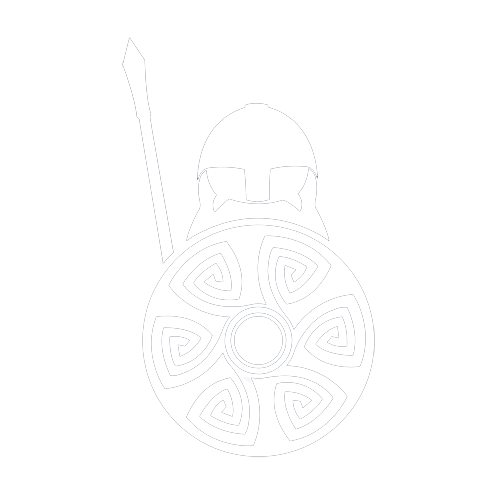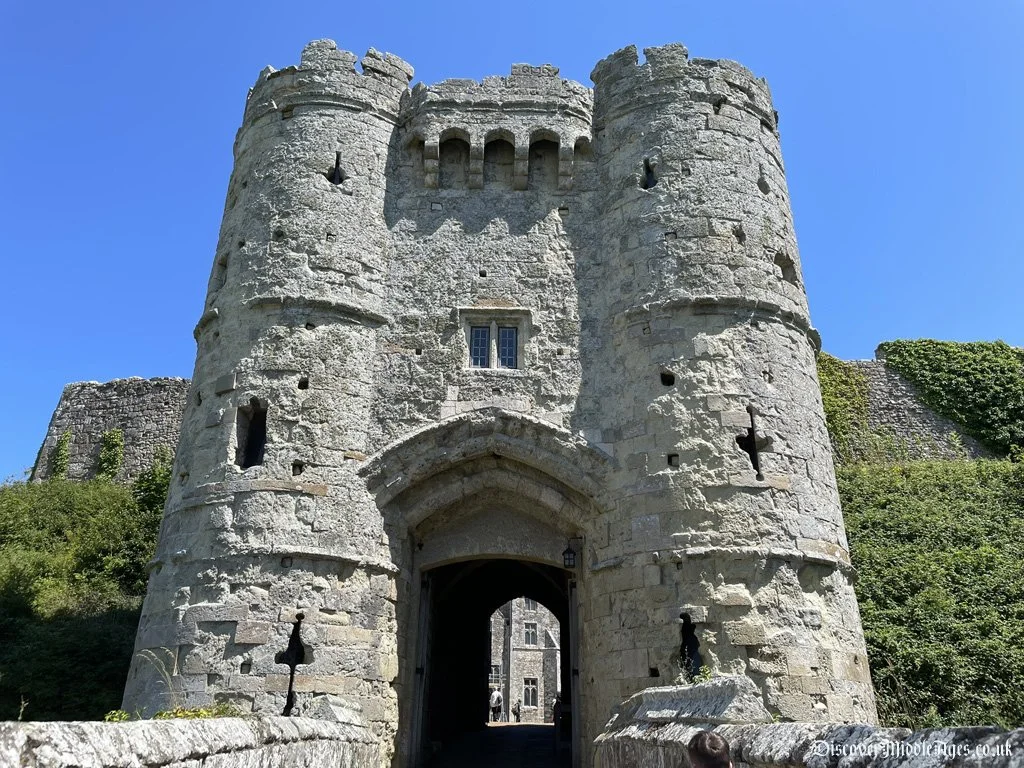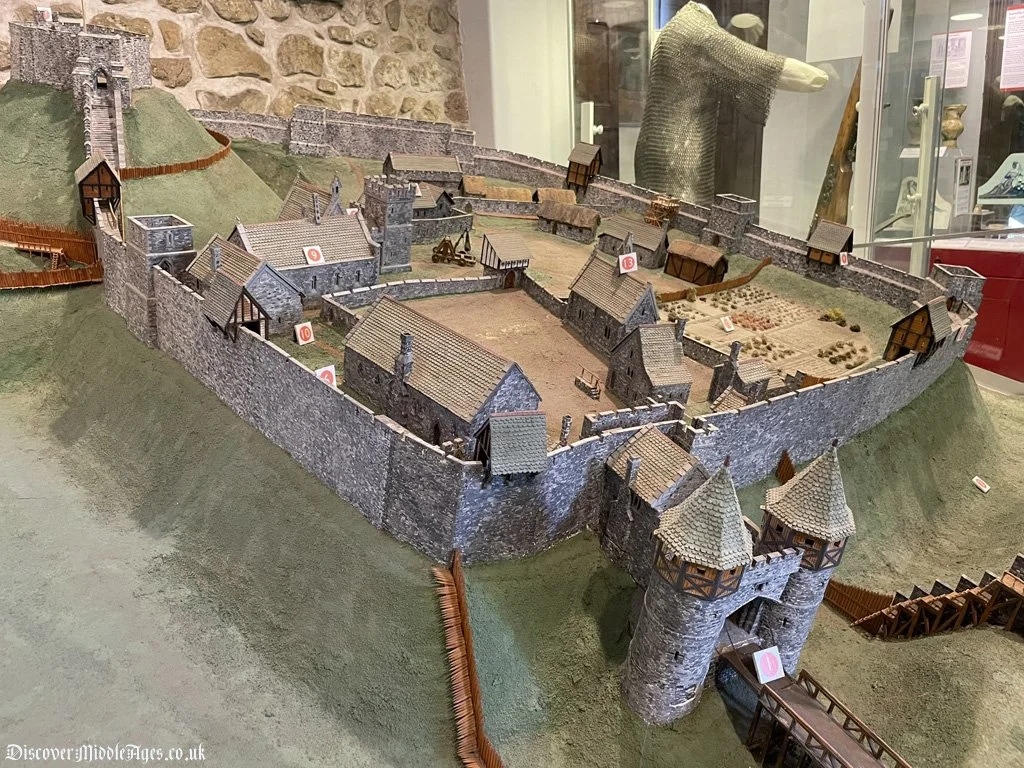Carisbrooke Castle The Fortress and Prison
Positioned atop a hill in the heart of the Isle of Wight, Carisbrooke Castle stands as a monument to centuries of English history. From its origins as a Saxon fort to its later development into a Norman stronghold and royal prison, Carisbrooke has seen it all: battles, sieges, royal intrigue and even imprisonment of a king.
From Saxon Fort to Norman Stronghold
The origins of Carisbrooke Castle stretch back to Roman times, with evidence suggesting that the site may have been used as a fort. By the time of the Anglo-Saxon period, from around 544 AD, it had evolved into a more established fortification to guard the island from Viking raids.
The Viking Siege
One of the earliest recorded sieges of Carisbrooke Castle, or at least the site it was built on, was an attack by Viking forces. During the late Saxon period, Viking raids were common along the southern coast of England, and the Isle of Wight was a frequent target. It’s believed that the Vikings attacked the site in circa 1000 AD, but there is little detailed information about this siege. The fortifications at this time were likely wooden, and they may have been destroyed or heavily damaged during the Viking incursions.
The Norman Influence
Carisbrooke’s prominence truly began with the Norman Conquest of 1066. The Isle of Wight was of strategic importance, and William the Conqueror gave the Isle to his kinsman William Fitz Osbern, who started to build a wooden castle on top of the burh.
By the late 11th century, Carisbrooke had developed into a formidable castle, with thick walls and a keep designed to defend against any invaders. The impressive stone keep, which still dominates the skyline today, was added in the 12th century and remains one of the most striking features of the castle.
Throughout the Norman period, Carisbrooke Castle served as a critical military installation. Its strategic position allowed it to monitor the waters surrounding the Isle of Wight and act as a deterrent against potential attacks from both the French and the Scots. The castle was fortified with a curtain wall, towers, and a gatehouse, enhancing its defensive capabilities.
Carisbrooke's military importance continued well into the medieval period, where it played a role in various conflicts, including skirmishes with invading forces. The stronghold was frequently used to house troops, manage local defences and serve as a base for operations against enemies.
The de Redvers Family
One of the most notable members of the Redvers family was Baldwin de Redvers, who became the first Earl of Devon in the early 12th century. He was a loyal supporter of King Henry I and was granted extensive lands and privileges on the Isle of Wight, which included control over Carisbrooke Castle.
As the lords of the Isle of Wight, the Redvers family held significant power and authority over the island. They were responsible for the administration of justice, local governance and defence against external threats. The Redvers family maintained their stronghold at Carisbrooke Castle, using it as a residence and centre of political activity.
The Redvers family played a crucial role in defending the Isle of Wight during the turbulent medieval period. They were involved in various military campaigns and conflicts, particularly during the civil wars of the 12th century, including the Anarchy (1135–1154), which was a civil war between the forces of King Stephen and Empress Matilda. The castle served as a strategic point for launching military operations and coordinating defences.
The influence of the Redvers family began to wane in the late 13th century when the last of the direct male line, Isabella de Redvers, married into the de Forz family (Fortibus). This alliance brought new connections and power but also marked the end of the Redvers’ direct control over Carisbrooke Castle. Eventually, the castle came under the ownership of various other noble families and the Crown.
The French Raid
During the Hundred Years' War between England and France. In 1377, a force of French raiders landed on the Isle of Wight and launched an attack on Carisbrooke Castle. This incident is often referred to as the French Raid.
The French forces attacked the castle with the intention of capturing it, but they were ultimately unsuccessful. According to accounts, the castle's defenders managed to hold off the assault, possibly when bowman Peter de Heynoe shot and killed the French commander! But the castle’s strong fortifications and strategic location on a hilltop played a vital role too. The French raiders were repelled, though they went on to ravage the surrounding countryside before leaving the island.
The raid spurred the further strengthening of Carisbrooke Castle’s defences. In the years following the attack, new drum towers around the main gatehouse were added, to bolster the castle against future assaults.
Royal Connections and The Imprisonment of King Charles I
Carisbrooke Castle’s place in history was solidified during the 17th century, when it became the prison of King Charles I. Fleeing from captivity in Hampton Court during the English Civil War, Charles sought refuge at Carisbrooke, hoping the island’s governor would support his cause. However, the governor’s loyalty lay with Parliament, and Charles was imprisoned within the castle walls from 1647 to 1648. He made several unsuccessful attempts to escape, including an infamous incident where he got stuck in a window!
The king’s imprisonment at Carisbrooke adds a poignant layer to the castle’s history, as it was the last place Charles I lived as a free man before his execution in 1649. The room where he was held can still be visited, offering a glimpse into this dramatic chapter of British history.
Carisbrooke Castle Through the Centuries
In 1596, George Carey was appointed as the Governor of the Isle of Wight, a position that came with the responsibility of overseeing the island’s defences and maintaining order. He was tasked with ensuring the security of the island during a time when England faced threats from Spain and internal conflicts.
While the imprisonment of Charles I is perhaps the most famous episode in Carisbrooke’s history, the castle continued to play a significant role in the centuries that followed. After the Civil War, the castle became the official residence of the Governor of the Isle of Wight. It was during this time that Queen Victoria’s daughter, Princess Beatrice, moved into Carisbrooke, making it her summer home and significantly contributing to its preservation.
By the 19th and early 20th centuries, Carisbrooke Castle was no longer needed as a military fortress, and its focus shifted to conservation and restoration. Thanks to Princess Beatrice’s influence, the castle was preserved and opened to the public. Today, it stands as a reminder of the island’s rich history and the strategic importance it held throughout the ages.
Carisbrooke Castle Model
The Norman Keep
The Norman keep at Carisbrooke Castle is one of its most prominent features, dating back to the late 12th century. Built on the highest point of the site, the keep was a critical defensive structure designed to withstand attacks and provide a secure retreat for the castle's inhabitants in times of siege. Its strategic location atop a motte (an artificial mound) gives it commanding views over the surrounding countryside, and enabled defenders to spot approaching enemies from afar.
The keep’s thick stone walls and narrow windows reflect its purpose as a military stronghold. Inside, there were living quarters for the castle’s garrison, storerooms, and additional fortifications to protect against invaders. The steep steps leading up to the keep emphasize its defensive nature, making it difficult for attackers to reach the top.
Today, visitors can climb the keep to enjoy panoramic views across the Isle of Wight.
The Well House
The well house is one of its most unique features of the castle, located within the inner courtyard. This 16th-century building houses a deep well, vital for supplying water to the castle’s inhabitants, especially during times of siege. The well itself is an impressive 49m deep, carved through solid rock to ensure a reliable water source.
What makes Carisbrooke’s well house particularly notable is the use of a large treadmill, traditionally powered by donkeys, to draw water from the depths of the well. The donkeys would walk inside the wheel, turning it to raise a bucket of water. This innovative system allowed the castle to maintain a steady supply of fresh water without needing to leave the safety of its walls.
Today, visitors can see this historic treadmill in action. Donkeys, cared for at the castle, still demonstrate the traditional method of water-drawing, providing an interactive glimpse into the castle’s medieval daily life.
The Great Hall and Museum
The Great Hall was once the centre of social and political life, and now serves as part of the Carisbrooke Castle Museum, housing a rich collection of artifacts that span a thousand years. Originally built by Isabella de Redvers (Isabel de Forz) with her chamber at one end, and her private chapel at the other, the Great Hall was a place where important guests were entertained, and local affairs were managed.
Today, the Great Hall retains much of its medieval charm, with features like large windows, stone walls, and an imposing fireplace that reflect its historic role as a gathering place for feasts and ceremonies. The adjacent rooms that were once living quarters for the governor and his family have been converted into display spaces for the museum.
The museum was founded by Princess Beatrice, Queen Victoria’s daughter, in 1898. It houses a fascinating collection of historical artifacts, including medieval weapons, armour, portraits and personal items belonging to key figures in the castle's history, such as King Charles I, who was imprisoned at Carisbrooke.
The Chapel of St Nicholas
The Chapel of St. Nicholas at Carisbrooke Castle is a small yet significant building, located within the castle grounds. It stands on the site of an earlier medieval chapel that once served the religious needs of the castle’s garrison and residents.
The current chapel, St. Nicholas in Castro, was built in 1904 as a war memorial to commemorate the island’s fallen soldiers from the Boer War and later, those who served in World War I and II. It was commissioned by Princess Beatrice, the daughter of Queen Victoria, who was also the Governor of the Isle of Wight at the time. Princess Beatrice was deeply involved in the restoration and upkeep of Carisbrooke Castle, and the chapel was part of her efforts to preserve its historical and memorial significance.
The chapel is modest in size but beautifully designed, blending medieval-inspired architecture with early 20th-century elements. Inside, visitors can see memorial plaques dedicated to the island’s soldiers, along with stained-glass windows depicting scenes from the life of Christ and tributes to the island’s military history.
The Chapel of St. Nicholas continues to serve as a place of worship and reflection, and each year, it is the site of commemorative services honouring those who fought in both world wars.
Legends of Carisbrook Castle
The Donkey and the Well
The legend of the donkey that powered the treadmill used to draw water from the well is well-known. It is said that the well's water had magical properties, granting good fortune to those who drank from it.
The Ghost of King Charles I
It is believed that the spirit of King Charles I haunts the castle, especially the areas where he was imprisoned before his execution. Visitors have reported sightings of a spectral figure resembling the king.
The Curse of the Black Dog
This legend tells of a ghostly black dog that roams the castle grounds. Sightings of the dog are thought to foretell misfortune or tragedy, making it a figure of fear and intrigue.
The Grey Lady of the Castle
A romantic legend surrounds a beautiful noblewoman who fell in love with a commoner. When their love was discovered, she faced a tragic choice between her family and her heart. It is said that her spirit wanders the castle in search of her lost love.
The Treasure of Carisbrooke
Stories of hidden treasure buried within the castle walls, left behind by knights and noblemen, abound. This treasure is rumoured to be cursed, bringing misfortune to anyone who seeks it.
The Phantom Knight
Some visitors have reported encounters with a phantom knight who appears at dusk, believed to be a guardian of the castle's secrets.
The Haunting of the Great Hall
The Great Hall of Carisbrooke Castle is said to be haunted by the spirits of former residents. Strange noises, footsteps and flickering lights have been reported.
Visiting Carisbrooke Castle
Carisbrooke Castle is run and managed by English Heritage. For details on opening times, facilities and refreshments please visit:
https://www.english-heritage.org.uk/visit/places/carisbrooke-castle/
Address: Castle Hill, Newport, Isle of Wight, PO30 1XY
























